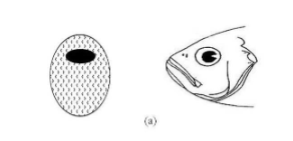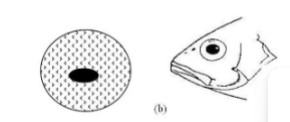Marine Vertebrate Zoology LEC 2
1/71
Earn XP
Description and Tags
LEC 2
Name | Mastery | Learn | Test | Matching | Spaced |
|---|
No study sessions yet.
72 Terms
External anatomy has two characteristics, what are they?
Form and Function
In form there is Phylogeny, what are some examples of it?
Development of modern fishes, Relationships among groups, and identification
In Function there is Ecology, what are some examples of it?
Resource acquisition, Predator avoidance, and reproduction
Basic teleost body plan, the section where the head is facing?
Anterior
Basic Teleost body plan, Looking at the side of the fish?
Lateral
Basic Teleost body plan, looking at the back or top of the fish?
Dorsal
Basic Teleost body plan, the section of the tail?
Posterior
Basic Teleost Body Plan, the section of the belly or underside of the fish?
Ventral
There is three separate ways to measure a fish, what are they called?
Total, Fork, and Standard length
How do you measure total length on a fish?
From the mouth to the tip of the upper lobe of caudal fin
How do you measure fork length on a fish?
From the mouth to the where the split of the caudal fin (like a fork road)
How do you measure standard length on a fish?
From the mouth to the middle of the Peduncle
What are the major external features?
Overall body shape, mouth shape and position, fins, and skin and scales.
There is three different mouth position, what are they?
Superior, Terminal, Subterminal, and inferior

What is this mouth position in this picture?
Superior

What is this mouth position in this picture?
Terminal

What is this mouth position in this picture?
Subterminal(/inferior)
Some ancestral teleost have a ______ dorsal with soft rays only.
single
Carp, goldfish, catfish spines ______ true spines but are bundles of fused rays
are not
More derived teleost typically have an _____ spinous dorsal and a ______ soft dorsal.
anterior…posterior
What are some characteristics of Spiny portion of a dorsal?
Hard, pointed, unsegmented, unbranched, and solid
What are some characteristics of (Rays) soft portion of a dorsal?
Soft, not pointy, segmented, usually branched, and bilateral with left and right halves
What’s the original function of the Median fins dorsal?
Stabilizer
In median fins dorsal has been modified in many ways, what are they?
Recessed groove/dorsal finlets in fast swimmers, lost in rays, confluent with caudal and anal in eels, suction disk in remorars, venom delivery system in stonefish, locking mechanism in triggerfish, fishing rod (illicium) and bait (esca) in frogfishes
In median fins caudal, where is it?
Its the “tail” fin
What is the base of the fin called?
Caudal peduncle
What is the primary function of the caudal?
propulsion (used as a rudder in tetraodontids and hunt prey in thresher sharks
In Protocercal caudal, what are some characteristics of the caudal?
Primitive undifferentiated fin(dorsal, caudal, anal) extending around the posterior end in adult lancelets, agnathans, and larvae of more advanced fishes
In Heterocercal caudal, what are some characteristics of the caudal?
Unequal lobed tail with vertebral column extending into upper lobe- Chondrichthyes and primitive bony fishes such as sturgeons
In Homocercal caudal, What are some of the characteristics of the caudal?
Symmetric arrangement of caudal fin rays attached to series of hypural bones posterior to the last vertebra.( Note: hypural plates are ventral to upward directed urostyle, so not internally symmetrical)
In Leptocercal caudal, what are some characteristics of the caudal?
Similar to a protocercal, but considered to be secondarly derived, not primitive -lungfishes, coelocanths, rattails, and many eel-like fishes
Homocercal has many shapes, what are some of them?
Truncate, Emarginate, Luncate, Forked, Rounded, and Convex
In the median anal fins, where is typically located?
found posterior of the anus
The anal fins on “soft-rayed” fishes, how is the anal fin made up of?
entirely made up of soft rays
The anal fins on “spiny-rayed” fishes, how is the anal fin made up of?
one to several spines followed by soft rays
Fast swimming species can also have _____ finlets
anal
What are the least shown variation among fishes?
Lost in ribbonfishes, elongated and primary locomotory fin, and anterior part modified into gonopodium/andropodium in males of internal fertilizing species.
What are some characteristics of the ancestral paired pelvic fins of the “soft-rayed” fishes?
Floating girdle, Abdominal position, and all soft rays
What are some characteristics of the a derived paired pelvic fins of the “spiny-rayed” fishes?
Some floating, some attached to skull, thoracic (or even jugular) position, and one to several spines followed by soft rays
Paired pelvic fins are sometimes ____ in some groups.
lost
In paired pectoral fins, what are some characteristics?
Rays only and Typically connected to skull
What are some characteristics of fish skin?
Multilayered organ covering body, mechanical protection, UV protection, Mucus glands, Venom glands, Photophores, Chromatophores, sensory receptors, and Alarm cells (schreckstoff)
There is five different scale types, what are they?
Placoid, Cosmoid, Ganoid, Cycloid, and Ctenoid
What scales are called “dermal denticle” but its not entirely accurate? It consist of both epidermal and dermal layers (human teeth)
Placoid scales
Placoid scales are characteristics of the _________.
Chondrichthyes
What scales do not grow with age, are homologous with teeth in all vertebrates, and elasmobranch teeth are evolutionary derivatives?
Placoid scales
What kind of scales are found in fossil coelacanths and lungfishes, grow by adding bone underneath, and was probably derived from fusion of placoid scales?
Cosmoid scales
In Cosmoid scales, it was formed what three layers?
dense bone, spongy vascularized bone, and cosmine layer ( noncellular dentine covered in thin layer of vitrodentine)
What kind of scales are found in fossil actinopterygians and extant chondrostei (sturgeons, paddlefishes, reedfishes, and birchirs) and usually rhomboidal in shape with articulating peg-and-socket joints between them?
Ganoid scales
How are cosmoid scales modified into Ganoid?
cosmine and vitrodentine replaced by dentine and ganoine
Which scale(s) have almost dermal with little to no enamel-like layer and evolved from ganoid scales by loss of ganoine and thinning of dermal plate?
Cycloid and Ctenoid scales
What are the two layers apart of the Cycloid and Ctenoid scales?
Surface bony layer and deeper fibrous layer
What is the surface bony layer?
organic framework impregnated with calcium phosphate and carbonate
What is the Deeper Fibrous Layer?
Collagen
What scale(s) are present in vast majority of bony fishes and overlap like shingles on a roof?
Cycloid and Ctenoid scales
What are the Biomechanics of Swimming key points?
Body shape and swimming behavior must overcome extreme density of water, different swimming types, and many species don’t always fit the status quo.
What are the characteristics of water?
800x denser than air, 50 times more viscous, and contains 95% less oxygen
What kind of air density does animals (birds and land animals) need to overcome gravity, efficient propulsion that pushing against the ground or use of wings to “lift”?
Low Density of air
What kind of air density is aquatic animals need to overcome drag and propulsion typically involves pushing against the water?
High density of air
What is determined by extreme density of water?
Body shape and locomotory behavior
How do fish overcome small gravity deficit?
Using air bladders and lipid sequestration
What the major hindrance to locomotion?
Drag
What is fictional drag?
Friction between water and surface, determined by smoothness (mucus prod. and scale shape) & surface area (fin shape), and it increases with velocity.
What is Pressure drag?
Pressure differences caused by movement, determined by body shape, and increases with velocity squared
How did Tuna reduce drag?
Fusiform body, retract paired and median fins into depressions, smooth skin, narrow peduncle with keel, and fins lifting for propulsion.
What kind of form is trunk and tail undulations, flexible bodies, everything but the head contributes forward propulsion, greater ability to move through dense obstruction (reverse), and slow due to long body?
Anguilliform
What kind of form is moderately flexible body, many teleost, both posterior body and tail contribute forward thrust, good balance of efficiency, speed, and maneuverability, and low aspect ratio tail better for rapid acceleration from dead start?
Subcarangiform
What kind of form is Moderately stiff body, Many faster swimming teleosts, Posterior body and tail contribute forward thrust, but mostly tail, Sacrificing some efficiency and maneuverability for increased speed, and Higher aspect ratio tail better for more sustained high-speed swimming?
Carangiform
What kind of form is Relatively inflexible bodies, Only high-aspect-ratio tail contributes to forward propulsion, Tail originates from narrow peduncle, often with keel - reduces inefficient lateral thrust, Hinge and special tendons allow maintenance of ideal angle of attack while increasing efficiency and power, Highly efficient and fast, but takes time to accelerate - not good for fast start, Tightly linked with endothermy, and High red to white muscle ratio?
Thunniform
What kind of form is Tail oscillations and Electricity producing/sensing
fish need to keep body straight to sense electrical field?
Ostraciiform
There is non-swimmers in fish, what are some characteristics?
Some walk, “tiptoe” along the bottom with modified pectoral or pelvic fin rays, and some even fly with aerial locomotion
Swimming in sharks characteristics?
Increasing internal pressure with increasing speed stiffens sharks' skin, acts as secondary attachment point for swimming muscles, elasticity contributes to recovery phase of each undulation, Efficiency enhanced through complex interaction between dorsal fin and upper lobe of caudal, and Unresolved debate about function and efficiency of heterocercal tail